英语:Unit3 Topic1 SectionB教案(仁爱版八年级上)
八年级英语上册 Unit 3《Our Hobbies》Topic 1 Section B 教案 仁爱版
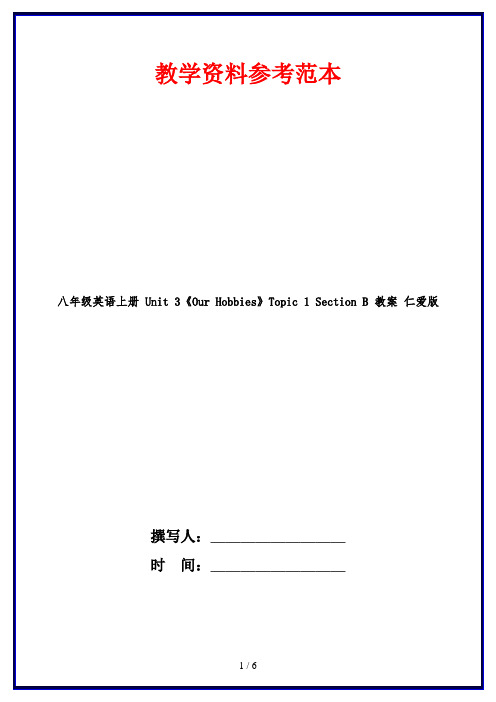
(1) I used to enjoy listening to rock music.
(2) I didn’t use to play soccer, but now I like it.
4. Go on talking about interests and hobbies and learning how to express likes and dislikes:
(引出used to do sth.句型。)
(板书,教师适当讲解并要求学生掌握。)
used to do sth.
T:Please make sentences withused to do sth.Volunteers?
S5: I used to enjoy dancing.
S6: I used to like skating.
S2: My hobby is listening to music. I like it because it makes me happy.
T:How about you, S3?
S3: I’m interested in collecting stamps. Collecting stamps is great fun and I can learn a lot from stamps.
(教师出示一幅水彩画,引出painting。)
T: This is apainting. It’s very beautiful. One of my friends gave it to me. He loves paintings a lot.
仁爱版英语八上Unit 3 Topic 2《What sweet music》(SectionB)教

仁爱版英语八上Unit 3 Topic 2《What sweet music》(SectionB)教学设计一. 教材分析《仁爱版英语八上Unit 3 Topic 2》主要介绍了西方的音乐文化。
通过本节课的学习,学生能够了解西方音乐的不同类型和特点,提高他们的跨文化交际能力。
本节课的主要内容包括:爵士乐、摇滚乐、古典音乐等。
教材内容丰富,贴近学生的生活,有利于激发学生的学习兴趣。
二. 学情分析八年级的学生已经具备了一定的英语基础,对音乐也有一定的兴趣。
但部分学生可能对西方音乐了解不多,因此教师在教学过程中应注重引导学生了解和欣赏西方音乐。
此外,学生们的学习动机多样,有的学生希望通过学习提高自己的音乐素养,有的学生则可能对英语歌曲更感兴趣。
因此,在教学过程中,教师应充分考虑学生的个体差异,满足不同学生的学习需求。
三. 教学目标1.知识目标:学生能够掌握与西方音乐相关的词汇和表达方式,如jazz,rock, classical music等。
2.能力目标:学生能够用英语简单介绍自己喜欢的音乐类型,提高他们的跨文化交际能力。
3.情感目标:通过本节课的学习,学生能够更加了解和欣赏西方音乐,提高他们的音乐素养。
四. 教学重难点1.重点:学生能够掌握与西方音乐相关的词汇和表达方式。
2.难点:学生能够用英语流畅地介绍自己喜欢的音乐类型,并能够表达出音乐的特点。
五. 教学方法本节课采用任务型教学法、交际法和文化导入法。
通过设置各种任务,引导学生积极参与课堂活动,提高他们的语言运用能力。
同时,通过交际法,培养学生们的团队合作精神。
此外,通过文化导入法,让学生了解西方音乐的文化背景,提高他们的跨文化交际能力。
六. 教学准备1.教师准备:教师需要熟悉教材内容,了解学生的学习需求,提前准备相关的教学材料,如课件、视频等。
2.学生准备:学生需要预习教材内容,了解将要学习的内容,并准备自己的音乐作品,以便在课堂上展示。
七. 教学过程1.导入(5分钟)教师通过播放一首西方音乐,如爵士乐、摇滚乐或古典音乐,引导学生进入学习状态。
仁爱版八年级英语上册Unit2Topic1.SectionB教学设计
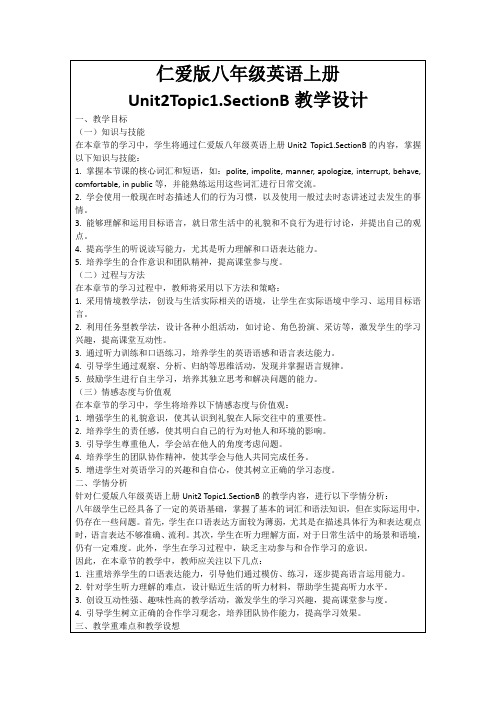
-教师给予反馈、指导,帮助学生查漏补缺。
(五)总结归纳
1.教学活动设计:
-教师引导学生回顾本节课所学内容,总结知识点。
-学生分享学习收获,教师给予评价、鼓励。
2.教学目标:
-帮助学生巩固所学知识,形成知识体系。
-提高学生的学习自信心,激发学习兴趣。
3.教学过程:
2.学会使用一般现在时态描述人们的行为习惯,以及使用一般过去时态讲述过去发生的事情。
3.能够理解和运用目标语言,就日常生活中的礼貌和不良行为进行讨论,并提出自己的观点。
4.提高学生的听说读写能力,尤其是听力理解和口语表达能力。
5.培养学生的合作意识和团队精神,提高课堂参与度。
(二)过程与方法
在本章节的学习过程中,教师将采用以下方法和策略:
-教师引导学生回顾本节课所学词汇、语法、听力等知识点。
-学生分享学习收获,教师给予积极评价、鼓励。
-布置课后作业,为下一节课的学习做好铺垫。
五、作业布置
针对仁爱版八年级英语上册Unit2 Topic1.SectionB的教学内容,以下为作业布巩固所学词汇、语法知识。
-引导学生从文化角度认识礼貌行为的重要性,培养其良好的跨文化交际能力。
四、教学内容与过程
(一)导入新课
1.教学活动设计:
-利用图片、视频等多媒体资源,展示日常生活中礼貌和不良行为的场景,引导学生关注和思考。
-邀请学生分享自己在生活中遇到的不礼貌行为及感受,激发学生对本节课主题的兴趣。
2.教学目标:
-引起学生对礼貌行为的关注,激发学习兴趣。
4.鼓励学生互相交流、讨论,共同完成作业,培养合作精神。
-通过小组讨论,让学生分享自己遇到的不礼貌行为及感受,激发学生的学习动机。
仁爱初中英语八上《Unit 3Topic 1 What's your hobby》word教案A .doc
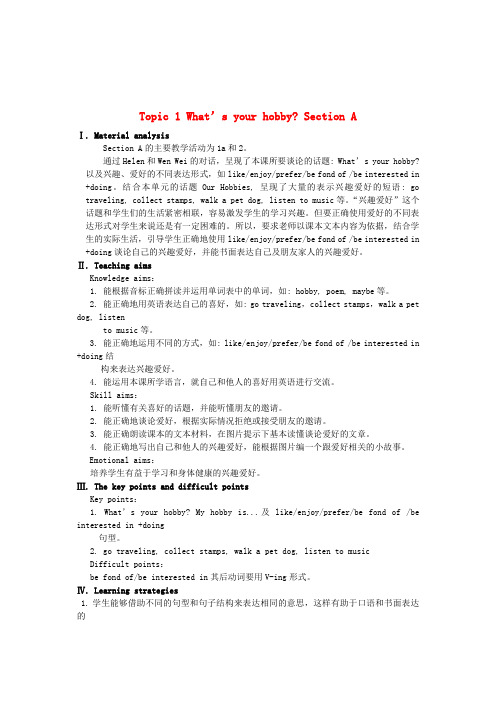
Topic 1 What’s your hobby? Section AⅠ. Material analysisSection A的主要教学活动为1a和2。
通过Helen和Wen Wei的对话,呈现了本课所要谈论的话题: What’s your hobby?以及兴趣、爱好的不同表达形式,如like/enjoy/prefer/be fond of /be interested in +doing。
结合本单元的话题Our Hobbies, 呈现了大量的表示兴趣爱好的短语: go traveling, collect stamps, walk a pet dog, listen to music等。
“兴趣爱好”这个话题和学生们的生活紧密相联,容易激发学生的学习兴趣。
但要正确使用爱好的不同表达形式对学生来说还是有一定困难的。
所以,要求老师以课本文本内容为依据,结合学生的实际生活,引导学生正确地使用like/enjoy/prefer/be fond of /be interested in +doing谈论自己的兴趣爱好,并能书面表达自己及朋友家人的兴趣爱好。
Ⅱ. Teaching aimsKnowledge aims:1. 能根据音标正确拼读并运用单词表中的单词,如: hobby, poem, maybe等。
2. 能正确地用英语表达自己的喜好,如: go traveling,collect stamps,walk a pet dog, listento music等。
3. 能正确地运用不同的方式,如: like/enjoy/prefer/be fond of /be interested in +doing结构来表达兴趣爱好。
4. 能运用本课所学语言,就自己和他人的喜好用英语进行交流。
Skill aims:1. 能听懂有关喜好的话题,并能听懂朋友的邀请。
2. 能正确地谈论爱好,根据实际情况拒绝或接受朋友的邀请。
仁爱英语八年级上册Unit3,Topic1,SectionA公开课教案
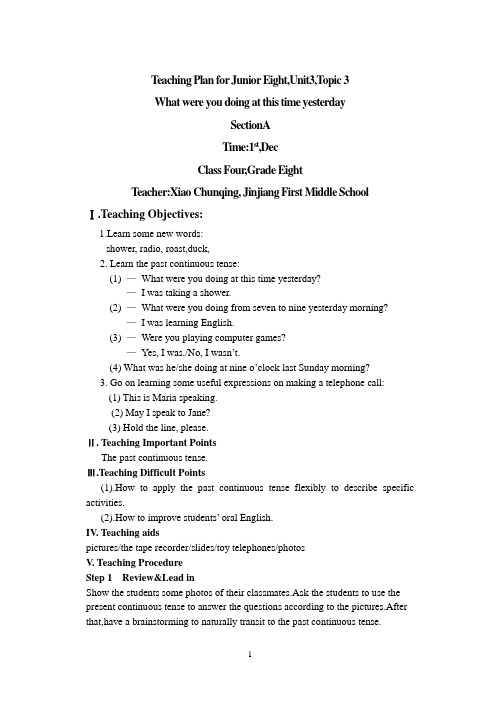
T eaching Plan for Junior Eight,Unit3,T opic 3What were you doing at this time yesterdaySectionATime:1st,DecClass Four,Grade EightT eacher:Xiao Chunqing, Jinjiang First Middle SchoolⅠ.Teaching Objectives:1.Learn some new words:shower, radio, roast,duck,2. Learn the past continuous tense:(1) —What were you doing at this time yesterday?—I was taking a shower.(2) —What were you doing from seven to nine yesterday morning?—I was learning English.(3) —Were you playing computer games?—Yes, I was./No, I wasn’t.(4) What was he/she doing at nine o’clock last Sunday morning?3. Go on learning some useful expressions on making a telephone call:(1) This is Maria speaking.(2) May I speak to Jane?(3) Hold the line, please.Ⅱ. Teaching Important PointsThe past continuous tense.Ⅲ.Teaching Difficult Points(1).How to apply the past continuous tense flexibly to describe specific activities.(2).How to improve students’ oral English.IV. Teaching aidspictures/the tape recorder/slides/toy telephones/photosV. Teaching ProcedureStep 1 Review&Lead inShow the students some photos of their classmates.Ask the students to use the present continuous tense to answer the questions according to the pictures.After that,have a brainstorming to naturally transit to the past continuous tense.Step 2 Presentation1.Listen to the tape and answer the questions.2. Read after the tape,fill in the blanks and underline the important words,phrases and sentences.3. Give the students some minutes to read the dialogue by themselves and ask some students to act out the dialogue in pairs.Step 3 PracticeA guessing game.Ask the students to use their imagination to guess what was he/she doing in the pictures.Step 4 ConsolidationAsk and answer in pairs after the example.Step 5 SummaryLead the students to have a quick looking back on the teaching content in this period.Step 6 HomeworkMake a survey about your group members 'activities at different times last Sunday morning.Talk about it with your group members to find who has spent the most interesting Sunday and then report it to your class.Time What were you doing?7:00—8:00 a.m.8:00—9:00 a.m.9:00—10:00 a.m.10:00—11:00 p.m.Section BThe main activities are 1a, 1c and 2a. 本课重点活动是1a, 1c 和2a. Ⅰ.Teaching aims and demands 教学目标 1. Learn some new words and useful phrases:agree, pleasant, agree with sb., handsome, useful, sad, make faces, laugh 2. Learn some useful sentences: (1)I thought it was just so-so. (2)I thought he was very brave! (3)It ’s nothing serious.(4)Miss Wang was angry with me.3. Go on learning the past continuous tense:(1)—What were you doing at this time last night? —I was watching a Harry Potter movie.(2)Because I made faces and made my classmates laugh when she was giving us a lesson.(3)You weren ’t listening to the teacher.4. Learn to express agreement and disagreement: —I think classical music is pleasant. I agree with you. / Yes, I think so. I don ’t agree. / No, I don ’t think so. I think it ’s boring. Ⅱ. Teaching aids 教具—挂图/课件/录音机/小黑板/卡片Ⅲ. Five-finger Teaching Plan 五指教学方案Step 1 Review 第一步复习(时间:6分钟)通过创设情景,表演对话复习过去进行时,导入新课。
仁爱版英语八年级上册Unit1__Topic3__SectionB__精品教案

Unit1 Topic3 SectionB 精品教案Ⅰ. Material analysisSection A and Section B 的内容整合,用三个课时上完。
本节课为单元第二课和第三课时,用两课时上完。
主要活动为Section B 的1a 和3a, 3b。
通过Kangkang 和Michael相约去参加运动会,呈现了本课所要学的语法重点Future Tense with shall。
相约中,依次呈现了:What shall we take? When shall we meet? Where shall we meet? 等功能性语言。
对话中呈现了重点短语:take sth …, make it half past six等。
本对话呈现了孩子们亲密无间的友情,旨在让学生在学会课本语言知识的同时,向Kangkang 和Michael学习,善于表达自己的感情,在参加集体活动中提升同学间的友情。
语音学习要求学生掌握两个辅音字母在一起第一个辅音字母的轻读现象;学生能正确认识元音在句中的弱读现象,并能正确朗读。
Ⅱ. Teaching aimsKnowledge aims:1. 能正确认识两个辅音字母在一起第一个辅音字母的轻读现象;学生能正确认识朗读元音在句中的弱读现象,并能正确朗读发音。
2. 能听懂含有以下短语的英语对话或文章:take sth. for…, make it half past six, catch up with, neck and neck, run into等。
3. 能正确地理解下列句子和短语,并能加以运用:What shall me take?When shall we meet?take sth …, make it+时间、地点或价钱。
4. 学生能正确理解并运用shall将来时,能运用shall进行写作。
Skill aims:1. 能听懂相约见面的对话,能听懂对运动场景描述的文字材料。
仁爱版英语八上Unit3Topic1《What’syourhobby》(SectionC)说课稿

仁爱版英语八上Unit 3 Topic 1《What’s your hobby》(SectionC)说课稿一. 教材分析仁爱版英语八上Unit 3 Topic 1《What’s your hobby》(Section C)是一篇关于个人爱好的阅读材料。
通过描述不同人物的不同爱好,引导学生学会询问和介绍个人的爱好,培养他们开口交际的能力。
本节课主要通过阅读理解,让学生掌握相关词汇和句型,并能运用到实际生活中。
二. 学情分析八年级的学生已经掌握了基本的英语语法和词汇,具备一定的阅读理解能力。
对于本节课的内容,他们容易产生共鸣,因为爱好是每个人都会有的。
但部分学生可能在表达能力上还存在一定的问题,需要教师在教学中给予指导和鼓励。
三. 说教学目标1.知识目标:学生能掌握描述个人爱好的相关词汇和句型,如“What’syour hobby?”, “I like playing basketball.”等。
2.能力目标:学生能通过阅读理解,提高自己的英语阅读能力。
3.情感目标:学生能积极参与课堂活动,大胆表达自己的爱好。
四. 说教学重难点1.重点:描述个人爱好的词汇和句型的运用。
2.难点:如何准确、流畅地表达自己的爱好。
五. 说教学方法与手段1.任务型教学法:通过设置各种任务,让学生在完成任务的过程中,自然地学会描述个人爱好的词汇和句型。
2.情境教学法:创设各种情境,让学生在真实的语境中,学会表达自己的爱好。
3.小组合作学习:通过小组讨论,培养学生的合作精神和团队意识。
六. 说教学过程1.导入:教师通过提问,引导学生谈论自己的爱好,激发学生的学习兴趣。
2.阅读理解:学生独立阅读课文,回答相关问题,教师给予解答和指导。
3.新课导入:教师引导学生学习描述个人爱好的词汇和句型。
4.课堂实践:学生进行小组讨论,用所学的词汇和句型描述自己的爱好。
5.总结提升:教师对学生的表现进行评价,总结课堂所学。
七. 说板书设计板书设计如下:What’s your hobby?•I like playing basketball.•She enjoys listening to music.•He spends his free time reading books.八. 说教学评价教学评价主要通过以下几个方面进行:1.学生课堂参与度:观察学生在课堂上的表现,是否积极参与、主动发言。
仁爱版八年级英语上Unit3Topic1SectionA教学设计

3、情感态度与价值观
1)、能够与同伴积极合作,参与课堂活动,大胆实践,共同完成学习任务。
2)、能形成广泛的兴趣爱好,活泼开朗的个性和对生活、未来的积极态度。
3)、学生在宽松活泼的课堂气氛中,始终保持着浓厚的学习兴趣,体会到学习英语与使用英语的成就感和乐趣,增强自信心。
5)、能在教师的指导下实行简单的采访活动并形成书面表达。
2、过程与方法
1)、学生积极主动参与各项课堂活动,利用观察、发现、分析、归纳等方法理解语言规律,边学边用,活学活用。
2)、学生采用自主学习和小组合作学习的方法并与小组合作伙伴使用角色扮演的方法熟练掌握课文对话。
3)、通过师生对话、两两对话、小组交流等形式让学生体验交际性英语教学过程,掌握英语听说的基本方法,体验合作学习的快乐。
2)、初始水平:此前学生已完成七年级上、下册以及八年级第一、二单元的系统学习。学生已有过学习、体会合作学习的经历,具有良好的合作意识和团队精神。喜欢游戏、比赛等多种刺激同时作用的学习方式。但是初二学生两极分化现象凸显,学习水平也参差不齐。
3)、信息素养:初二学生已经有了一定的信息素养,能够从书本、电视、网络等多种渠道获取信息,但信息的加工、提取、使用的水平还较弱。他们对感兴趣的事物有较强的获取信息的欲望。
number the pictures.
Check the answers
5. Lead the Ss to
read and master the
new phrases.
1. Think and guess
the meanings of new
phrasesaccording to
仁爱英语八年级上Unit1Topic3Section B教案
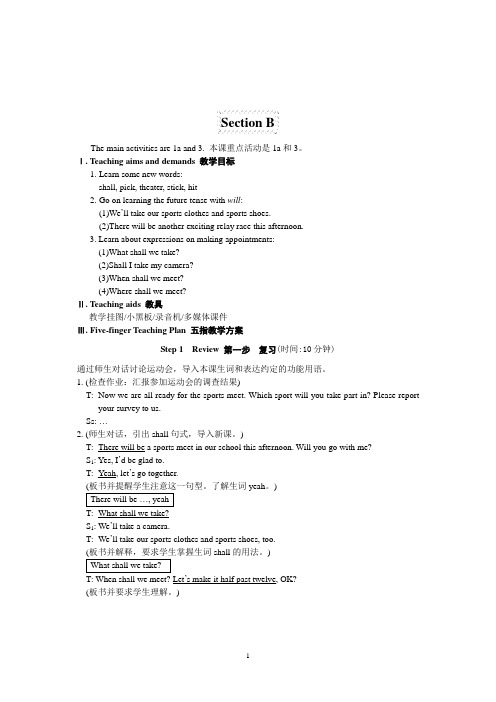
Section BThe main activities are 1a and 3. 本课重点活动是1a和3。
Ⅰ. T eaching aims and demands 教学目标1. Learn some new words:shall, pick, theater, stick, hit2. Go on learning the future tense with will:(1)We’ll take our sports clothes and sports shoes.(2)There will be another exciting relay race this afternoon.3. Learn about expressions on making appointments:(1)What shall we take?(2)Shall I take my camera?(3)When shall we meet?(4)Where shall we meet?Ⅱ. T eaching aids 教具教学挂图/小黑板/录音机/多媒体课件Ⅲ. Five-finger T eaching Plan 五指教学方案Step 1 Review 第一步复习(时间:10分钟)通过师生对话讨论运动会,导入本课生词和表达约定的功能用语。
1. (检查作业:汇报参加运动会的调查结果)T: Now we are all ready for the sports meet. Which sport will you take part in? Please report your survey to us.Ss: …2. (师生对话,引出shall句式,导入新课。
)T: There will be a sports meet in our school this afternoon. Will you go with me?S1: Y es, I’d be glad to.T: Y eah, let’s go together.yeah。
仁爱版英语八年级上册Unit1-Topic3教案

精心整理Unit1Topic3教案SectionAThemainactivitiesare1aand2a.本课重点活动是1a和2a。
Ⅰ.Teachingaimsanddemands教学目标1.Learnsomenewwordsandphrases:relayrace,excited,hear,havefun,lotsof,preparefor,makefriends2.Learnthefuturetensewith will:(1)Ithink I’llhavelotsoffun.(2)I’lldomybest.Iwon’tlose.(3)I’llmakemanyfriendsduringthesportsmeet.(4)I’lljoinintheteachers’relayrace.3.Talkaboutschoolsportsmeet:(1)Iwilltakepartintheschoolsportsmeet.(2)Whichsportwillyoutakepartin?(3)I’llbeinthelongjumpandthehighjump.(4)I’msureourschoolsportsmeetwillbeexciting.Ⅱ.Teachingaids教具录音机/幻灯片Ⅲ.Five-fingerTeachingPlan五指教学方案Step1Review第一步复习(时间:8分钟)复习上个话题的语法、句型及功能用语,引出本课生词、语法及话题,导入新课。
1.(让学生进行链式问答,复习上一话题的重要语法和功能用语。
)(师生谈话导入本课话题和生词。
)T:Doyouknowwhoismyfavoritesportsplayer?Ss: WethinkyourfavoritesportsplayerisMichaelJordan.T: Yes.IsheChinese?Ss: No,heisn’t.T:Wealllikesportsbecausewewanttokeephealthy.Ifthereisasportsmeetinourschool,I’lljoinintherelayr ace.IthinkIwillhavelotsoffun.Whichsportwillyoutakepartin?(引出词组:relayrace,havefun,lotsof;语法:Futuretensewith will;话题:Whichsportwillyoutakepartin?) (板书并要求学生掌握。
仁爱英语八年级上Unit3Topic1SectionB教学设计
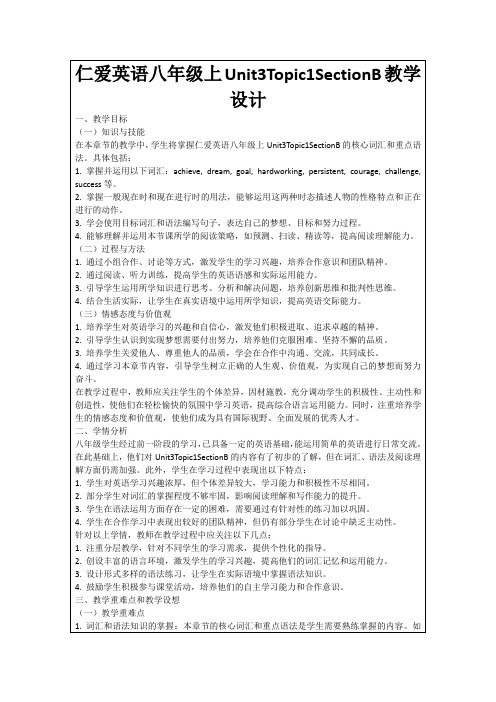
3.学生在语法运用方面存在一定的困难,需要通过有针对性的练习加以巩固。
4.学生在合作学习中表现出较好的团队精神,但仍有部分学生在讨论中缺乏主动性。
针对以上学情,教师在教学过程中应关注以下几点:
1.注重分层教学,针对不同学生的学习需求,提供个性化的指导。
2.词汇和语法教学:
-采用图片、实物等直观教具辅助词汇教学,增强记忆效果。
-利用思维导图、歌曲、游戏等多种形式复习和巩固语法知识。
3.阅读教学:
-预读阶段:引导学生根据标题和图片进行预测,激活背景知识。
-快速阅读:要求学生快速阅读全文,回答概括性问题,把握文章大意。
-精细阅读:通过设置细节性问题,帮助学生深入理解文章,提炼关键信息。
2.语法教学:
-讲解一般现在时和现在进行时的用法,通过示例句子展示两种时态在实际语境中的应用。
-设计语法练习,让学生在实际操作中掌握语法知识。
(三)学生小组讨论
1.教师将学生分成小组,每组选择一个梦想或目标作为讨论主题。
2.小组成员用英语讨论如何实现这个梦想或目标,并记录下关键步骤和所需条件。
3.各小组轮流展示讨论成果,其他小组进行评价和提问。
-阅读反思:引导学生思考文章中所体现的价值观和情感态度,与自身经历相结合。
4.口语和写作训练:
-设计小组讨论和角色扮演活动,让学生在模拟真实语境中练习口语表达。
-提供写作框架和指导,帮助学生撰写关于梦想和目标的短文。
-进行同伴互评和教师评价,给予学生及时的反馈,指导他们改进语言表达。
5.课后作业:
-设计分层作业,满足不同层次学生的学习需求。
仁爱英语八年级上Unit3Topic1SectionB教学设计
仁爱版八年级上册英语教学设计:Unit3Topic2SectionB

3.能够理解并运用一般将来时谈论自己的梦想和目标。
4.学会使用相关的连接词,如:first, then, finally, however, although, in addition等,使句子和篇章更加连贯。
5.提高学生的听说能力,能够听懂并参与关于成功、梦想和目标的讨论。
3.引导学生学会关爱他人,互相鼓励和支持,共同成长。
4.培养学生具备积极向上的心态,学会珍惜每一次机会,勇往直前。
5.增强学生的团队协作意识,让他们明白团队精神对于个人成长的重要性。
二、学情分析
八年级学生经过前一阶段的学习,已经具备了一定的英语基础,包括词汇、语法和基本的听说读写能力。在此基础上,他们对英语学习有了更深入的认识,同时也对自身的学习需求有了更明确的了解。然而,在Unit3 Topic2的学习过程中,学生可能面临以下挑战:
2.每个小组挑选一个代表分享他们的梦想和计划,其他小组成员给予评价和鼓励。
3.引导学生讨论如何面对困难和挫折,互相鼓励和支持,实现练习环节将设计以下活动:
1.完成教材中的练习题,如填空、选择、改写句子等,巩固所学词汇和语法知识。
2.让学生编写一段关于自己成功经历的小故事,运用一般现在时和一般过去时进行描述。
仁爱版八年级上册英语教学设计:Unit3Topic2SectionB
一、教学目标
(一)知识与技能
在本章节的学习中,学生将掌握以下知识与技能:
1.能够熟练运用本单元的生词和短语,如:achieve, goal, success, effort, give up, opportunity, encourage, support等,并在实际语境中进行运用。
仁爱版八年级英语上册u3T1Sb教案

《仁爱版》八年级英语(上)Unit 3 Our HobbiesTopic 1 What habbies did you use to have?Section B教案设计The main activities are 1a, 3a and 4.I. Teaching aims and demands:a. Knowledge objectives:(1) To enable my students to understand new words and phrases, “ share, e-mail address, VCD, pop music, in one’s spare time, comic”.(2) Learn the pattern of “used to”.(3) Go on talking about interests and hobbies not only now but also in the past and learn how to express likes and dislikes.b. Ability objectives(1) To devel op my students’ listening, reading and speaking strategies.(2) To develop the students’ vocabulary about hobbies and interests.(3) To enlarge the students’ sense of cooperation in their studies through activitiesc. Moral objectives(1) To guide my students into a better understanding that if you share, you will be happy.(2) To increase my students’ interest in learning English.(3) To strengthen their confidence in learning English.II. Teaching keys and difficulties1. To express their hobbies not only now, but also in the past.2. How to instruct Ss to share and cooperate with others.III. Teaching aidsboard, tape recorder, PPT, OHP, and some material objects, such as oranges, VCDs, comics and cards.IV. Teaching proceduresStep 1 Warm up and lead in1. Listen and sing a song called “Are you happy?” before the class.2. Greeting.3. Ask the Ss, “Are you happy if I share my orange?”And teach the new word-----share.eg:4. Using “share” to go on teaching the new words“e-mail address, VCD, spare, in one’s spare time, and comic.”eg:Step 2 Review1. Share hobbies with the Ss.a. Tell the Ss my hobbies, then encourage the Ss to tell me theirsb. While talking, use the brainstorming to review what hobbies we have learnt.eg:Step 3 (part 2) Look, listen and match1. Tell the Ss we have 8 more friends to share their hobbies with us, but we need to match their hobbies with the right English phrases.2. Let the Ss look and match3. Have the Ss listen to the tape recorder and number the sentences with the pictures.eg:Step 4 (1a) Look, listen and say.1. Listen and answer 2 questions.What does Wen Wei often do in his spare time?What’s Helen’s hobby?2. Let the Ss read the conversation in roles.First, the boys will be Wen Wei and the girls will be Helen.Then, change the boys’ and the girls’ roles.After that, ask two pairs to act it out.3. Pair workLet the Ss share hobbies like what Helen and Wen Wei do with their partners.First give them an example.Then give them 3 minutes to practise.After that, ask 2 or 3 pairs to show their dialogues.Step 5. (3a) Read and understand1. Use my own experience to lead in “used to”T: I used to dance, but now I don’t like it. I like reading comics.eg:2. Read 3a for the first time to fill in the blanks.He used to be a _______ fan, but now he is _________.He used to _______ , but now his hobbies are _______.He used to ________, but now he likes _________.Let the Ss compare “used to” and “now”3. Read 3a again and choose the right answersHe ____________a soccer fan.A. used to beB. didn’t use to beHe ____________ enjoy sports.A. used toB. didn’t use toHe ____________like collecting paintings.A. used toB. didn’t use toLet the Ss compare “used to” and “didn’t use to”Step 6 (part 4) Group work1. To give everyone a paper to do a survey.eg:2. Ask them to share hobbies with their classmates, and get their hobbies as many as they can.3. Make an example for the SsFirst ask them to write down their classmates’ or friends’ names.Then use the Q: Can you tell me your hobbies?Tell them that their answers can be one of these: Yes, I enjoy cooking now.I didn’t use to read comics, but now I like it.I used to dance, but now I hate it.4. If the Ss don’t understand, give one more example.5. Give the Ss about 5 minutes to do it.6. After that, ask some individuals to tell about his or her hobbies and his or her friends’ hobbies.Step 7 Summary1. Review the new words and the phrasesshare, e-mail address, VCD, pop music, in one’s spare time, comic2. Review the key sentences.What do you often do in your spare time?I often go fishing.I used to listen to music, but now I hate it.I didn’t use to play soccer, but now I like it.Step 8 Project and Homework1.Oral work:A. Read the dialogue and the passage 5 times to your friends.B. Make a conversation with your friend and act it to 2 of your classmates(Ask your friends to sign their names on your book after you finish your Oral Work)2. Written work:A. Make a brainstorming, you must write at least 10 hobbies.B: Write 3 sentences about hobbies.板书设计:Unit 3 Our HobbiesTopic 1 What hobbies did you use to have?Section BKey words Key Sentencesshare What do you often do in your spare time?e-mail address I often go fishing.VCDpop music I used to listen to music, but now I hate itsparecomic I didn’t use to play soccer, but now I like it.Reflecting (教学反思)本节课主要针对本班学生已具备的英语素质和对英语学习的热情而设计的,并且充分利用了现有的教育教学资源,以新课标精神为指导思想,努力改善学生学习的方式。
Unit3 Topic1 SectionC 教案 2022-2023学年仁爱版英语八年级上册

Unit 3 Topic 1 What’s your hobby?Section C【教学构思】一、教材分析:本课属于课标话题人与自我——“个人情况(Personal background)”中兴趣与爱好(Interests and hobbies)项目,主要谈论制作剪贴簿本课属于课标功能意念表“态度(Attitudes)”中偏爱和优先选择(Preference)项目,主要学习收集和制作剪贴簿,并激发学生了解剪贴簿的兴趣。
主要教学活动为1a和2。
通过介绍scrapbook的制作,呈现了单词background,paper,glue,scissors,stick,friendship,stupid等。
通过scrapbook的制作过程,引出在谈论事情或制作的时候需要注意条理性。
在2中也将used to do sth.延伸到特殊疑问句形式。
最后,引导学生能模仿scrapbook的制作过程,用英文讲述a class book的制作过程。
二、设计说明:根据学情和本课的语法及话题,本节课的教学设计将读与写相结合,以1a阅读文本为载体,学会通过图片和语境猜词,学会把握文章主题和篇章结构,构建思维导图;在语言生成阶段,循序渐进,从文本理解到课文复述,帮助学生完成写作任务。
本课在重、难点突破的方法上有所创新,教师通过2的对话延伸used to do sth.的特殊疑问句形式,通过梳理阅读文本结构,引导学生构建读后思维导图,引导学生在说和读的基础上,通过关键词句,确立写作思路和基本框架,进行创作。
【教学目标】1.能基本听懂本课文本材料,及他人对爱好的阐述,学会以“听”的方式理解语言意义;2.能正确地口头介绍scrapbook的制作流程,构建语言意识,提升“说”的语言能力;3.能正确朗读课本的文本材料,并能读懂相关的文本材料,培养学生“读”的语言能力;4.能正确模仿本课课文,通过书面形式介绍a class book的制作过程,发展学生多元学习策略,提高“写”的语言能力。
仁爱版八年级英语上册Unit3Topic1SectionB优质教案

八年级上册教案设计Unit3OurHobbiesTopic1What’syourhobby?SectionBⅠ.MaterialanalysisSectionB的主要教学活动为1a和3。
本节课主要通过Michael,Maria和Kangkang之间的对话,继续学习表示兴趣爱好的话题。
SectionB是对SectionA的延伸,谈论的内容也从谈论现在的兴趣爱好扩展到了对过去兴趣爱好的谈论,即usedtodosth和它的否定形式usednottodosth/didn’tusetodosth。
本小节第3部分主要谈论过去和现在爱好的对比。
学生们对兴趣爱好的话题很感兴趣。
但是要正确使用usedtodosth表达过去的兴趣爱好,也是有困难的,所以在设计这堂课的时候,老师应该将语言知识、语言点融入实际生活当中,让学生感受到本话题的实用价值。
能够在生活中自由谈论现在和过去的兴趣爱好并能够进行书面表达。
Ⅱ.TeachingaimsKnowledgeaims:1.能根据音标,正确朗读出下列单词及简单短语:collection,doll,coin,pop,usedtodosth。
2.能在老师的引导下,判断出S在清辅音、元音、浊辅音和ts/ds中的不同发音。
3.能正确拼读并运用单词表中的单词,如:coin,hate,pop等。
4.能用usedtodosth/usednottodosth/didn’tusetodosth表示过去的兴趣爱好。
5.能运用本课所学语言,对过去和现在的兴趣爱好进行对比。
Skillaims:1.能听懂有关过去的兴趣爱好和现在的兴趣爱好进行对比的简单对话和陈述。
2.能正确地口头表达有关喜欢和不喜欢及它们的过去式的话题。
3.能正确朗读课本的文本材料,准确把握语音、语调及连读。
4.能正确地运用书面表达写出自己和他人现在及过去的兴趣爱好。
Emotionalaims:通过对SectionB的学习,要求学生明白在不同的兴趣爱好中,可以增加不同领域的知识。
仁爱版英语八年级上册:Unit 3 Topic 1 What's your hobby? Section B 课件(共27张PPT)

Read 1a and fill in the blanks.
Maria likes _co_l_le_c_t_i_n_g stamps and she _co_l_le_c_t_e_d_ them when she was in Cuba. She thinks we can learn a lot about _h_i_st_o_r_y_ and _pe_o_p_l_e_ from stamps. And now she has many beautiful Chinese stamps. Michael __us_e_d__t_o__ collect baseball cards when he was in America. Now __pl_a_y_in_g__ basketball is his hobby. Kangkang is interested in _s_w__im_m__in_g__ . The three children have different _h_o_b_b_i_e_s__ .
keep pets
listen to music watch TV
play computer games go shopping
play soccer
Example :
I used to enjoy pop music, but now I don’t like it. I love playing sports.
Yes, sb. used. No, sb. usedn’t.
把下列句子改为否定句和一般疑问句,并作肯定和否定回答。
My brother used to go swimming in the sea. 否定句:My brother _d_i_d_n_’t__u_s_e_/__u_s_e_d_n_’t__ to go swimming in the sea. 一般疑问句:__D_i_d__ your brother __u_se__t_o__g_o__ swimming in the sea ? Yes, _h_e__d_id__ . No, _h_e__d_i_d_n_’t_ . 一般疑问句:U__s_e_d_ your brother _t_o_g_o__ swimming in the sea? Yes, __h_e_u_s_e_d__ . No, _h_e__u_s_e_d_n_’t__ .
(整理)仁爱版八年级英语上册全册教案.
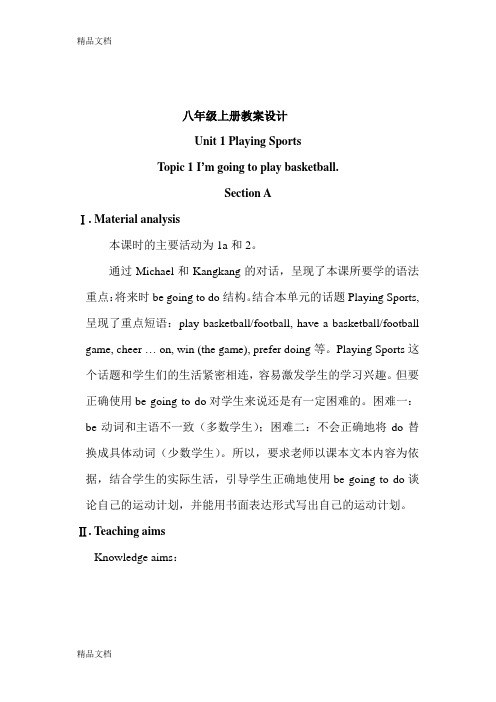
八年级上册教案设计Unit 1 Playing SportsTopic 1 I’m going to play basketball.Section AⅠ. Material analysis本课时的主要活动为1a和2。
通过Michael和Kangkang的对话,呈现了本课所要学的语法重点:将来时be going to do结构。
结合本单元的话题Playing Sports, 呈现了重点短语:play basketball/football, have a basketball/football game, cheer … on, win (the game), prefer doing等。
Playing Sports这个话题和学生们的生活紧密相连,容易激发学生的学习兴趣。
但要正确使用be going to do对学生来说还是有一定困难的。
困难一:be动词和主语不一致(多数学生);困难二:不会正确地将do替换成具体动词(少数学生)。
所以,要求老师以课本文本内容为依据,结合学生的实际生活,引导学生正确地使用be going to do谈论自己的运动计划,并能用书面表达形式写出自己的运动计划。
Ⅱ. Teaching aimsKnowledge aims:1. 能根据音标正确朗读出下列单词表中的单词:team, win, cheer,row, quite, during, against, practice…2. 能正确拼读并运用单词表中的黑体单词。
3. 能正确运用be going to do 表达运动计划。
4. 能正确地运用prefer doing结构表达喜好,如:prefer swimming, prefer rowing等。
5. 能运用本课所学语言,就自己的运动计划与他人交流。
Skill aims:1. 能听懂有关运动计划和运动爱好的简单对话和陈述。
2. 能正确地口头表达有关运动计划和运动爱好的话题。
- 1、下载文档前请自行甄别文档内容的完整性,平台不提供额外的编辑、内容补充、找答案等附加服务。
- 2、"仅部分预览"的文档,不可在线预览部分如存在完整性等问题,可反馈申请退款(可完整预览的文档不适用该条件!)。
- 3、如文档侵犯您的权益,请联系客服反馈,我们会尽快为您处理(人工客服工作时间:9:00-18:30)。
《仁爱版》八年级英语(上)Unit 3 Our HobbiesTopic 1 What hobbies did you use to have?Section B教案设计The main activities are 1a, 3a and 4.I. Teaching aims and demands:a. Knowledge objectives:(1) To enable my students to understand new words and phrases, “ share, e-mail address, VCD, pop music, in one’s spare time, comic”.(2) Learn the pattern of “used to”.(3) Go on talking about interests and hobbies not only now but also in the past and learn how to express likes and dislikes.b. Ability objectives(1) To devel op my students’ listening, reading and speaking strategies.(2) To develop the students’ vocabulary about hobbies and interests.(3) To enlarge the students’ sense of cooperation in their studies through activitiesc. Moral objectives(1) To guide my students into a better understanding that if you share, you will be happy.(2) To increase my students’ interest in learning English.(3) To strengthen their confidence in learning English.II. Teaching keys and difficulties1. To express their hobbies not only now, but also in the past.2. How to instruct Ss to share and cooperate with others.III. Teaching aidsboard, tape recorder, PPT, OHP, and some material objects, such as oranges, VCDs, comics and cards.IV. Teaching proceduresStep 1 Warm up and lead in1. Listen and sing a song called “Are you happy?” before the class.2. Greeting.3. Ask the Ss, “Are you happy if I share my orange?”And teach the new word-----share.eg:4. Using “share” to go on teaching the new words“e-mail address, VCD, spare, in one’s spare time, and comic.”eg:Step 2 Review1. Share hobbies with the Ss.a. Tell the Ss my hobbies, then encourage the Ss to tell me theirsb. While talking, use the brainstorming to review what hobbies we have learnt.eg:Step 3 (part 2) Look, listen and match1. Tell the Ss we have 8 more friends to share their hobbies with us, but we need to match their hobbies with the right English phrases.2. Let the Ss look and match3. Have the Ss listen to the tape recorder and number the sentences with the pictures.eg:Step 4 (1a) Look, listen and say.1. Listen and answer 2 questions.What does Wen Wei often do in his spare time?What’s Helen’s hobby?2. Let the Ss read the conversation in roles.First, the boys will be Wen Wei and the girls will be Helen.Then, change the boys’ and the girls’ roles.After that, ask two pairs to act it out.3. Pair workLet the Ss share hobbies like what Helen and Wen Wei do with their partners.First give them an example.Then give them 3 minutes to practise.After that, ask 2 or 3 pairs to show their dialogues.Step 5. (3a) Read and understand1. Use my own experience to lead in “used to”T: I used to dance, but now I don’t like it. I like reading comics.eg:2. Read 3a for the first time to fill in the blanks.He used to be a _______ fan, but now he is _________.He used to _______ , but now his hobbies are _______.He used to ________, but now he likes _________.Let the Ss compare “used to” and “now”3. Read 3a again and choose the right answersHe ____________a soccer fan.A. used to beB. didn’t use to beHe ____________ enjoy sports.A. used toB. didn’t use toHe ____________like collecting paintings.A. used toB. didn’t use toLet the Ss compare “used to” and “didn’t use to”Step 6 (part 4) Group work1. To give everyone a paper to do a survey.eg:2. Ask them to share hobbies with their classmates, and get their hobbies as many as they can.3. Make an example for the SsFirst ask them to write down their classmates’ or friends’ names.Then use the Q: Can you tell me your hobbies?Tell them that their answers can be one of these: Yes, I enjoy cooking now.I didn’t use to read comics, but now I like it.I used to dance, but now I hate it.4. If the Ss don’t understand, give one more example.5. Give the Ss about 5 minutes to do it.6. After that, ask some individuals to tell about his or her hobbies and his or her friends’ hobbies.Step 7 Summary1. Review the new words and the phrasesshare, e-mail address, VCD, pop music, in one’s spare time, comic2. Review the key sentences.What do you often do in your spare time?I often go fishing.I used to listen to music, but now I hate it.I didn’t use to play soccer, but now I like it.Step 8 Project and Homework1.Oral work:A. Read the dialogue and the passage 5 times to your friends.B. Make a conversation with your friend and act it to 2 of your classmates(Ask your friends to sign their names on your book after you finish your Oral Work)2. Written work:A. Make a brainstorming, you must write at least 10 hobbies.B: Write 3 sentences about hobbies.板书设计:Unit 3 Our HobbiesTopic 1 What hobbies did you use to have?Section BKey words Key Sentencesshare What do you often do in your spare time?e-mail address I often go fishing.VCDpop music I used to listen to music, but now I hate itsparecomic I didn’t use to play soccer, but now I like it.Reflecting (教学反思)本节课主要针对本班学生已具备的英语素质和对英语学习的热情而设计的,并且充分利用了现有的教育教学资源,以新课标精神为指导思想,努力改善学生学习的方式。
